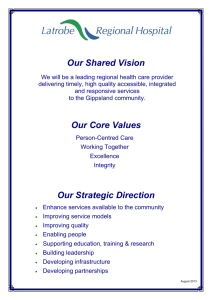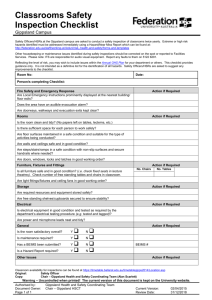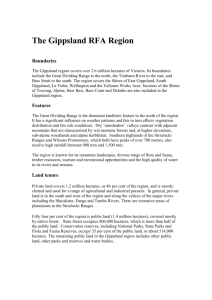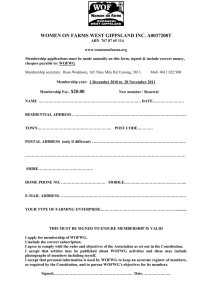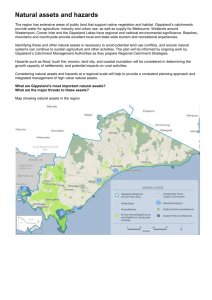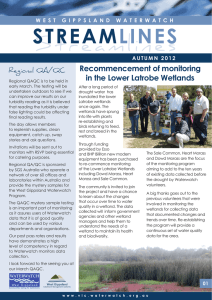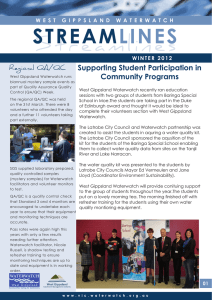Document 13167601
advertisement
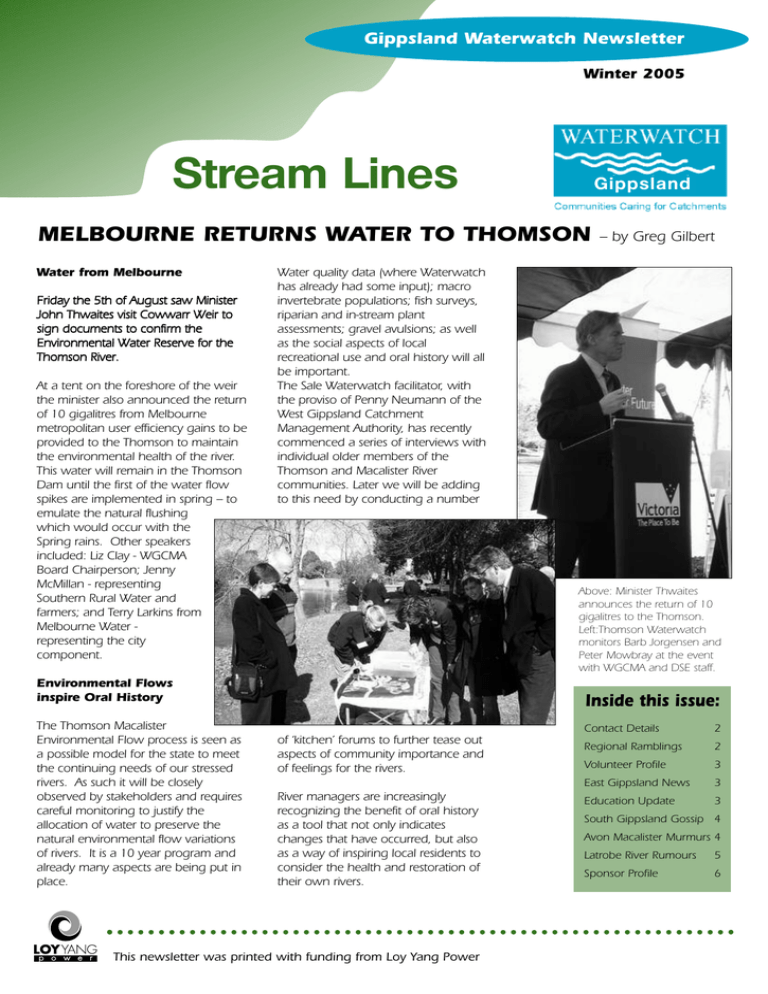
Gippsland Waterwatch Newsletter Winter 2005 Stream Lines Gippsland MELBOURNE RETURNS WATER TO THOMSON Water from Melbourne Friday the 5th of August saw Minister John Thwaites visit Cowwarr Weir to sign documents to confirm the Environmental Water Reserve for the Thomson River. At a tent on the foreshore of the weir the minister also announced the return of 10 gigalitres from Melbourne metropolitan user efficiency gains to be provided to the Thomson to maintain the environmental health of the river. This water will remain in the Thomson Dam until the first of the water flow spikes are implemented in spring – to emulate the natural flushing which would occur with the Spring rains. Other speakers included: Liz Clay - WGCMA Board Chairperson; Jenny McMillan - representing Southern Rural Water and farmers; and Terry Larkins from Melbourne Water representing the city component. Water quality data (where Waterwatch has already had some input); macro invertebrate populations; fish surveys, riparian and in-stream plant assessments; gravel avulsions; as well as the social aspects of local recreational use and oral history will all be important. The Sale Waterwatch facilitator, with the proviso of Penny Neumann of the West Gippsland Catchment Management Authority, has recently commenced a series of interviews with individual older members of the Thomson and Macalister River communities. Later we will be adding to this need by conducting a number Above: Minister Thwaites announces the return of 10 gigalitres to the Thomson. Left:Thomson Waterwatch monitors Barb Jorgensen and Peter Mowbray at the event with WGCMA and DSE staff. Environmental Flows inspire Oral History The Thomson Macalister Environmental Flow process is seen as a possible model for the state to meet the continuing needs of our stressed rivers. As such it will be closely observed by stakeholders and requires careful monitoring to justify the allocation of water to preserve the natural environmental flow variations of rivers. It is a 10 year program and already many aspects are being put in place. – by Greg Gilbert Inside this issue: of ‘kitchen’ forums to further tease out aspects of community importance and of feelings for the rivers. River managers are increasingly recognizing the benefit of oral history as a tool that not only indicates changes that have occurred, but also as a way of inspiring local residents to consider the health and restoration of their own rivers. This newsletter was printed with funding from Loy Yang Power Contact Details 2 Regional Ramblings 2 Volunteer Profile 3 East Gippsland News 3 Education Update 3 South Gippsland Gossip 4 Avon Macalister Murmurs 4 Latrobe River Rumours 5 Sponsor Profile 6 Calendar of Events East Gippsland Student River/ Enviromental Forum - Bairnsdale Environmental Expo – Bairnsdale East Gippsland 10 year Reunion – Bairnsdale National Water Week ‘Who Does What In Water’ Conference Frog Census Training - Latrobe Valley Powlett River Canoe Tour Thomson River Canoe Tour Catch a Carp Day – Lake Narracan Gippsland Waterwatch Communities Caring for Catchments Contacts: Nadine Cranenburgh West Gippsland Regional Coordinator 16 Hotham St, Traralgon 3844 Ph: (03) 5175 7800 Email: nadinec@wgcma.vic.gov.au Tammy Dawson Latrobe Facilitator 16 Hotham St, Traralgon 3844 Ph: (03) 5175 7800 Email: tammyd@wgcma.vic.gov.au Tanya Cowell South Gippsland Facilitator P.O. Box 99, Leongatha 3953 Ph: (03) 5662 4555 Email: tanyac@wgcma.vic.gov.au Greg Gilbert Sale region Facilitator 906 Dolphin Av, Golden Beach 3851 Ph: (03) 5146 3217 Email: ggil@netspace.net.au September 8th – contact Bec Van Der Heyden September 10th – contact Bec Van Der Heyden October 14th – contact Bec Van Der Heyden October 17th – October 23rd October 18th – contact Nadine Cranenburgh October – contact Tammy Dawson October 22nd – watch local papers for details November 19th – 20th – watch local papers for details December 4th – watch local papers for details REGIONAL RAMBLINGS by Nadine Cranenburgh & Becky Van Der Hayden In the west…. Welcome to the Winter edition of our newsletter. I have one sad announcement to make. Paul Puhar – the Waterwatch Farewell Paul Puhar Victoria Statewide – Waterwatch Project Officer – Victoria will be departing after seven years with the program. Goodbye Paul – you will be sadly missed! In the last few months volunteers have participated in QA/QC training with their facilitators – thanks to those who have taken the time to come along. Marni Speed Education and Professional Development Officer 16 Hotham St, Traralgon 3844 Ph: (03) 5175 7800 Email: marnis@wgcma.vic.gov.au I have also had the chance to visit our valued sponsors and talk about some exciting opportunities for co-operation. Megan Burns East Gippsland Regional Coordinator P.O. Box 1012, Bairnsdale 3875 Ph: (03) 5150 3576 Email: mburns@egcma.com.au We have been working with Waterwatch Victoria to upgrade our database in preparation for transferring data to the Victorian Data Warehouse – I will keep you up to date as this progresses. Becky Van Der Heyden East Gippsland Facilitator PO Box 1012, Bairnsdale 3875 Ph: (03) 5150 3577 Email: bvanderheyden@egcma.com.au Josh Puglisi Community Education & Projects Coordinator P.O. Box 260, Orbost 3888 Ph: (03) 5161 1222 Email: egwaterwatch@datafast.net.au Page 2 Stream Lines Winter 2005 In the east… For those who I haven’t had a chance to meet yet, I am the new East Gippsland Waterwatch Facilitator. I am currently working four days a week for Waterwatch; while Megan is happily travelling around South America! When she returns I will remain working four days as Megan has other work commitments to fill. There are some exciting events planned for the next few months – including two canoe tours and a Catch a Carp day at Lake Narracan - watch your local papers for details… Becky Van Der Heyden, the new East Gippsland Waterwatch Facilitator It’s been a busy time of the year, the Annual Data and Technical report and the Annual Community Education report have now been completed for 2004 2005. There are some really good graphs in the data report this year, thanks to good constant monitoring. If anyone would like a copy of our Annual Reports for this year please contact Megan or Becky and we will pass one on. We are now preparing for our two big events for this year, for National Water Week, we have the East Gippsland Student River/ Environmental Forum for all schools across East Gippsland and our ’10 year reunion’. EAST GIPPSLAND NEWS by Becky Van Der Heyden and Josh Puglisi Conversations with monitors over the past winter months in East Gippsland have focused on river flow and rainfall. Up at Cape Conran we have had 110 mm, 47 mm, 24 mm and 13 mm over four consecutive weeks. Creeks and wetlands across the region are filling and flowing. Swampy Creek near Cape Conran is flowing to the sea for the first time in 4 years. Water quality results have varied greatly as you would expect. Parts of the Cann River have shown increased turbidity but not nutrients. The flush of freshwater has reduced the salt levels in the Mallacoota Lakes and the freshwater in the Snowy is being monitored. An Environmental Expo gives the public a great opportunity to find out more about the local environment through the displays and activities provided. You are all most welcome to come along and have a look for yourselves. ‘The East Gippsland Student River/Environmental Forum’ aims to give interested students an opportunity to discuss river health, catchment issues, pollution, as well as interact with people working in natural resource management. We are also busily organising for our ‘10 Year Reunion’ of East Gippsland Waterwatch, the night includes guest speaker “Tammy Van Wisse” and volunteers receiving awards for 5 and 10 year service to Waterwatch. LEFT: The Wonnangatta River has a good flow at the moment; due to the recent rain and snow melt. ABOVE: Students learning about the environment Education Update by Marni Speed Volunteer Profile Name: George Martenyi T he in i ti a l fo r mal s e r i es o f pr o fe s s io n al de ve lo p men t s es s i o ns fo r “ G ip ps l and 's E n vi r o nm e nt a l E d u ca ti o n R e s o u rc e” ha s no w co me t o an e nd. T h e s e s s io n s r an i n a l l maj or to w n s i n t he Gi pps l an d L ake s C at c hme nt a nd p r ov i ded an ov er v i ew o f t he r es o u r ce , d em on s t ra t ed s ev er al o f t he s t u d en t ac ti v it i es an d al l o w ed f o r di s cu s s i o n of l o ca l ca s e s tu di e s an d i s s u es w it h t he gr o u p. I have had some very positive feedback about the resource and PD sessions from teachers from Warragul to Lakes Entrance and their level of enthusiasm during the sessions was very encouraging. My role now is to continue to support schools as they begin using the kit to design units of work and integrate the materials into their curriculum. I will also be revising the kit based on teachers suggestions and providing updates. With this update will also come an electronic version of the kit which will go out to all schools who have attended sessions. I look forward to becoming involved with many more schools over the next few months and continuing to promote Gippsland's Environmental Education Resource. Page 3 Stream Lines Winter 2005 Level Monitored: 3 Sites Monitored: Clifton Creek at Eastwood Road – CCK020; Mt Taylor Creek at Mt Taylor Bridge – CCK030; Clifton Creek at Boyd’s Road – CCK040; Clifton Creek at Boucher’s Road – CCk050 Monitoring regularity: Weekly Parameters monitored: Air temperature, Water temperature, pH Electrical Conductivity, Reactive Phosphorus, Turbidity Started monitoring: 20th August 2004 What do you enjoy most about Waterwatch? I enjoy putting my part in for the community by monitoring our water quality. Most memorable experience: Nearly stepping on a snake in the long grass in summer! Training Completed QA/QC Training 2005 Thankyou George – we appreciate your efforts! South Gippsland Gossip by Tanya Cowell After a brief stint in English summer I’m back to the short days of a South Gippsland winter. During July, Tammy and I completed a six day Facilitation course with the West Gippsland Landcare team. This course provided some interesting insight into group dynamics, as well as meeting and event facilitation. This was particularly helpful as I’m planning the Powlett River Canoe tour to be held in October, more information will be available closer to the event day. A thankyou dinner was held in Foster recently to farewell Adrian Rathjen and commend him for his more than eight years of involvement in the Nooramunga Corner Inlet water monitoring project. Adrian was a driving force behind the NCI Project and initiation of the unique and successful project setup that we continue to see almost a decade later. Adrian has retired as Chairman of the NCI Steering Committee, but still remains passionate about water quality issues and the NCI Project. Thankyou Adrian for your significant contribution. I have been out visiting water monitoring volunteers to test equipment, record the GPS co-ordinates of sites and update habitat surveys. Avon / Macalister Murmurs This has been a great opportunity to catch up with some very dedicated volunteers and to see how things are going out there on the river banks of the South Gippsland rivers. For those volunteers that I have missed; if you would like to make an appointment for me to come out and see you please don’t hesitate to call me on (03) 5662 4555. See above for a picture taken in Inverloch last week while I was out collecting a water sample, amazing to see snow on the beach! by Greg Gilbert Gippsland Grammar Junior’s Human Impact Study…. the effects of human impacts on our natural environment. As part of this study they have tested water from Lake Guyatt and netted and observed the macro invertebrate (small water bugs) population at the Sale Channel. Twenty enthusiastic year four pupils from Gippsland Grammar’s Port of Sale campus put their study to great use recently. As World Environment Day came and went in Sale these students headed out to Lake Guthridge and conducted a very effective cleanup along the lake’s southern shoreline. With teachers Di Rowarth and Liz Dawson they have been studying At Lake Guthridge the class donned gloves and towed wheelie-bins to clean up rubbish. A bicycle and a shopping trolley were pulled from the lake, but most prevalent among the garbage were tennis balls, this site being a catchment point from the local playing fields. The class also sprayed several Waterwatch stencil prints (‘What You Drop Our Rivers Cop’) about the concrete bases of the picnic tables; as further action in their plight. Not yet complete, the class presented at a pastoral session, to us the invited and other pupils of the school as a round up to their human impact study. Their story of the pelican, damselfly, duck and swan was a wonderful puppet play of great quality. Congratulations Class! Left: Gippsland Grammar Year 4 Students clean up Lake Guthridge. Above: Students spray a stencil at Lake Gyatt Sale. Page 4 Stream Lines Winter 2005 Latrobe River Rumours Morwell River Diversion… Part of the Yallourn Coal Field Development Project is the $120 million Morwell River Diversion project. This development was undertaken in order to secure future coal supplies and sustain the operation of the adjacent Yallourn W Power Station. Coal is currently being taken from the East Field area of the mine; however, this area has a limited life. The coal resource in the Maryvale field will provide coal for the ongoing operation of the power station. To give access to this field, it was necessary to divert the Morwell River. The Morwell River diversion flows along a by Tammy Dawson & Catherine Davis (TRU engery) 3.5 km elevated channel across the western end of the East Field mine, meeting with the Latrobe River. The previous diversion saw the Morwell River piped underground as this was accepted practice at the time. Due to greater environmental awareness today things are different with the river once again being exposed to daylight. The new 70 metre wide flood plain with an open low flow channel allows for further enhancement of the natural environment in and around the river, allowing native fish to travel upstream. Particular attention has been paid to ensuring that suitable habitat is available Note to volunteers… I would like to congratulate all the volunteers who participated in the Phys/Chem training and mystery sample determination in July. All results were encouraging and reflect the quality of the data collected. On behalf of the Waterwatch network I would also like to extend a warm welcome to several new volunteer monitoring groups: Peter Winter, Margaret and Eric Smith, Colin Bermingham, Kerry Matthews, Carolyn Roscholler, Mark Waller, Trafalgar PS, Neerim District SS, Churchill North PS, Morwell Park PS, and Morwell PS. Coming Soon – Standard Operating Procedures As part of Waterwatch West Gippsland’s Data Confidence Plan we will be producing Standard Operating Procedures (affectionately known as SOPs) for water quality testing equipment and procedures used by our volunteers. These SOPs will provide a step by step guide to carrying out each testing procedure, and ensure that all Waterwatchers are following the correct Page 5 Stream Lines Winter 2005 procedures to produce quality community water monitoring data. The SOPs will be a handy pocket size, with photographs to illustrate each procedure. They will also be laminated so that they you can take them with you into the field. Your facilitator will contact you in the coming months with more information… for aquatic species, such as frogs, that will live in the river diversion. Riffle strips and logs have been added to the channel to act as habitat and provide organic matter. The diversion incorporates native aquatic species such as Carex appressa – Tall Sedge, Hycopus australis – Gypsy Wort, Schoenoplectus validus – River Club Rush, together with wetland areas at either end. Of national significance are the Strezelecki gums that have been planted along the banks and are now thriving in their natural habitat. Below: The new Morwell River Diversion Sponsor profile: East Gippsland Water Company: East Gippsland Water us to systematically address our environmental issues and to continually improve our performance. How lon g sponsor in g Wa ter wa tch ? 8 years In te re stin g fac ts a bo u t th e c o mpa ny : EGW supplies water and wastewater services to East Gippsland in a cost effective and environmentally sustainable way. The areas served cover from Bairnsdale through to Mallacoota and most towns along the coast, and up to Omeo and Dinner Plain in the high country. Wha t is EGW doi ng for t he en vironm en t? EGW has an Environmental Management System in place, which has recently been certified by an independent auditor to the international standard ISO 14000, allowing Key Stakeholders EGW is one of the best performing water authorities in Victoria (and Australia) in terms of treated wastewater reuse - we reuse 100% of our treated wastewater for irrigation or other environmental purposes. Larger authorities around Melbourne are reusing as little as 2% of their treated wastewater. EGW does not have any major on stream dams that are regularly used to supply water to the community. EGW runs a save water campaign and encourages customers to use water wisely. EGW regularly performs energy audits to minimise power usage and greenhouse gas emissions where possible. We are in the process of putting in place a biodiversity strategy to minimise the chance of any of our operations or works disturbing rare and threatened species. H o w d o es E G W s u p po r t t h e Wa t e rw at ch program? EGW supports the East Gippsland Waterwatch program financially with a contribution every year. Occasionally, there is also cooperation between Waterwatch and EGW with public information displays and training on water and environmental issues. EGW considers it important to be involved in community projects that focus on people, water and the environment, as Waterwatch does. & Sponsors DPI/DSE Gippsland STREAM LINES – The Gippsland Waterwatch Newletter
